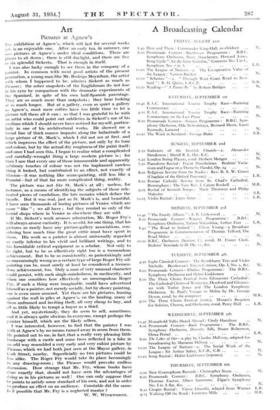Art
Pictures at Agnew's
THE exhibition at Agnew's, which will last for several weeks vet, is an enjoyable one. After an early tea, in summer, one i-ees pictures at Agnew's under ideal conditions. There are places to sit down ; there is still daylight, and there are live or six splendid Sickerts. That is enough in itself.
I was also lucky enough to see them in the company of a painter. In common with most good artists of the present generation, a young man like Mr. Rodrigo Moynihan, the artist with whom I happened to be, admires Sickert as much as Picasso ; the sober snapshots of the Englishman do not lose in his eyes by comparison with the dramatic experiments of the Spaniard, in spite of his own half-Spanish parentage. They are so much more than snapshots ; they bear looking at so much longer. But at a gallery, even so quiet a gallery as Agnew's, most mere critics have too little time to let a picture tell them all it can ; so that I was grateful to be with an artist who could point out subtleties in Sickert's use of his medium which I should never have noticed for myself, particu- larly in one of his architectural works. He showed me a broad line of thick mauve impish) along the balustrade of a large picture of St. Mark's, which I did not see at first, and which improves the effect of the picture, not only by its tone and colour, but by the actual dry roughness of the paint itself; and once I had seen this, I began to realize what a complicated and carefully-wrought thing a large modern picture is ; for hen I saw that every one of those innumerable and apparently arbitrary touches of colour was not the haphazard careless thing it looked, but contributed to an effect, not exactly of illusion-it was nothing like scene-painting, still less like a Pannini-but of that far more complicated thing, reality.
The picture was not like St. Mark's at all ; useless, for instance, as a means of identifying the subjects of those cele- brated pieces of vandalism, the late mosaics which deface the facade. But it was real, just as St. Mark's is, and beautiful. I have seen thousands of boring pictures of Venice which are more " like " ; we all have ; but they remind us only of the horrid shops where in Venice as elsewhere they are sold.
If Mr. Sickert's work arouses admiration, Mr. Roger Fry's will always arouse curiosity. It is so odd, for one thing, that his pictures so rarely have any picture-gallery associations, con- sidering how much time the great critic must have spent in them. His work as a painter is almost universally regarded as vastly inferior to his vivid and brilliant writings, and to his formidable critical equipment as a scholar. Not only to b? right, but to be so effectively right too is a tremendous achievement. But to be so consistently, so painstakingly and so unassumingly wrong as a certain type of large Roger Fry oil- painting can be, must surely at least be considered a tremen- dous achievement, too. Only a man of very unusual character could persist, with such single-mindedness, in mediocrity, and when one considers how effectively an unscrupulous Roger Fry, if such a thing were imaginable, could have advertised himself as a painter, not merely socially, but by showy painting, one is even more amazed. Yet there are his pictures, leaning against the -wall in piles at Agnew's, on the landing, many of them unframed and inviting theft, all very cheap to buy, and all as little likely to tempt-a buyer as a thief.
And yet, mysteriously, they do seem to sell, sometimes, and it is always quite obvious to everyone, except perhaps the painter himself, which are the likely sellers.
I was interested, however, to find that the painter I was with at Agnew's by no means turned away in scorn from them. He pointed out to me, in fact, that a really very pleasing little landscape with a castle and some trees reflected in a lake in an odd way resembled a very early and very cubist picture by Picasso, which we had both just seen at the Mayor gallery, in Cork Street, nearby. Superficially no two pictures could be less alike. The Roger Fry would take its place becomingly in any drawing-room ; the Picasso would provoke endless discussion. How strange that Mr. Fry, whose books have done exactly that, should not have seen the advantages of doing so in his pictures as well ! One can only suppose that lie paints to satisfy some standard of his own, and not in order to produce an effect on an audience. Constable did the same. Is it possible that Mr. Fry is a neglected master ?
W. W. WINKWORTLI.






































 Previous page
Previous page